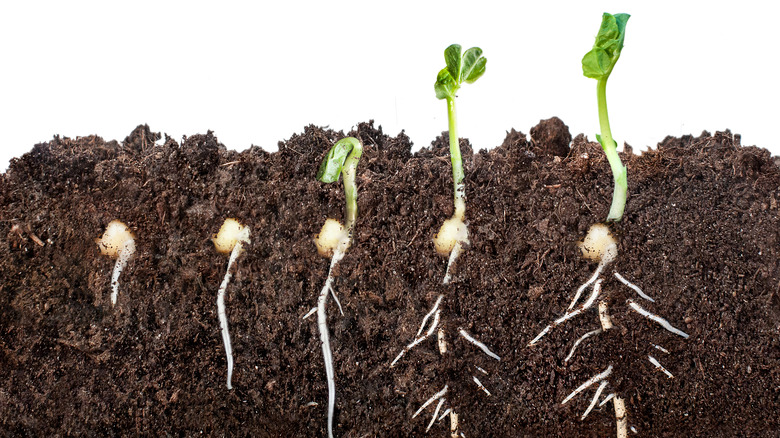How Plants Use Listening Skills To Find Water
Anyone who's read the German forester Peter Wohlleben's book "The Hidden Life of Trees: What They Feel, How They Communicate" has learned that plants are more sentient and intelligent than what we have historically thought. According to Smithsonian Magazine, trees have evolved to live in "colonies," where individual trees can communicate with one another through underground networks of fungi, warning each other about toxic insects attacking, or other threats.
There is also some evidence to suggest that trees have a sense of smell and taste, per Smithsonian Magazine. Let's say a caterpillar attacks a pine tree, for example. The pine tree can "taste" the caterpillar's spit and deploy defenses to protect itself. But it doesn't just repel the caterpillar by releasing something with a bad taste. Instead, it can actually release a pheromone that attracts one of the caterpillar's enemies, a parasitic wasp that lays eggs inside the caterpillars and kills them (via Smithsonian Magazine). In a 2017 study out of Australia, researchers found another sense plants can use to survive: listening.
The experiment
According to the study's author, evolutionary biologist Monica Gagliano, plants are good at "sniffing" for water to prevent dehydration by smelling the humidity in the air to determine where water is. But in a drought, or when plants are very far from a water source, they still manage to "sense" where it is. That led researchers at the University of Western Australia (UWA) to host an experiment in order to determine whether plants could "hear" their water sources.
In their experiment, researchers put a common garden pea plant into a container of soil, including a pipe divided into two parts (like an upside down "Y"). Then, the researchers played a series of sounds — white noise, real running water, and a recording of running water — to the plant through the tubes in each section, according to the UWA. What they found was that the roots of the pea plant started growing in the direction of the running water sound, but not the white noise or the recorded running water.
The implications
The study's findings indicate plants can "hear" the acoustics of the running water, rather than "feel" the moisture of running water. And they could even distinguish between the "fake," recorded running water sounds and the real thing (per Quartz). According to Gagliano, this raises the question of how noise pollution might be affecting plants' ability to detect water. If there are too many traffic sounds, for example, a plant might not be able to detect nearby water, and that could have further reaching effects on the animals that eat those plants to survive, per Gagliano. It also may explain why many tree roots tend to grow into sewer pipes underground, per UWA.
This isn't the first piece of evidence supporting the idea that plants can "hear," according to HuffPost. Through a process called "buzz pollination," plants can "listen" for the buzzing of a bee's wings and produce more pollen when they are nearby, according to Scientific American. Other research has shown a specific type of rock cress plant can tell the difference between wind sounds and a caterpillar's chewing sounds. When it detects the latter, it can release certain toxins to repel them, per Scientific American.
Wohlleben was initially viewed as a controversial scientist by many, and still is by some, for attaching "human-like" senses to trees (via Smithsonian Magazine). But what the research of Gagliano and many others is beginning to show is that "plant life" is sensical and sentient, and may be closer to "human life" than we once thought.


